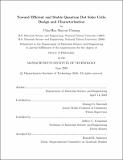| dc.contributor.advisor | Moungi G. Bawendi. | en_US |
| dc.contributor.author | Chuang, Chia-Hao Marcus | en_US |
| dc.contributor.other | Massachusetts Institute of Technology. Department of Materials Science and Engineering. | en_US |
| dc.date.accessioned | 2016-09-13T18:05:28Z | |
| dc.date.available | 2016-09-13T18:05:28Z | |
| dc.date.copyright | 2016 | en_US |
| dc.date.issued | 2016 | en_US |
| dc.identifier.uri | http://hdl.handle.net/1721.1/104105 | |
| dc.description | Thesis: Ph. D., Massachusetts Institute of Technology, Department of Materials Science and Engineering, 2016. | en_US |
| dc.description | This electronic version was submitted by the student author. The certified thesis is available in the Institute Archives and Special Collections. | en_US |
| dc.description | Cataloged from student-submitted PDF version of thesis. | en_US |
| dc.description | Includes bibliographical references (pages 155-167). | en_US |
| dc.description.abstract | This thesis focuses on the optical and electronic properties of lead sulfide (PbS) quantum dots (QDs) for the development of QD solar cells. Near-infrared active PbS QDs composed of earth-abundant elements have emerged as promising candidates for photovoltaic applications because of the solution-processability and a tunable energy bandgap that covers the optimal bandgap range for single and multi-junction solar cells. However, despite rapid progress, previous QD solar cells still show unsatisfactory efficiency and stability. In this thesis work, room-temperature solution-processed ZnO/PbS solar cells with high efficiencies and unprecedented air-stability have been successfully demonstrated. The major limiting factors in present QD solar cells and potential routes to further improving the device performance have also been elucidated. Owing to the versatile surface chemistry and high surface-to-volume ratio of QDs, the surface ligands play crucial roles in determining the optoelectronic properties. In this work, taking advantage of tunable electronic energy levels in QDs with different ligands, a new device architecture for solar cells has been designed. The architecture employs layers of QDs serving complementary functions, one as the main light absorbing layer and another as an electron-blocking/hole extraction layer. The device shows improved performance as a result of the relative band alignment between these QD layers, as confirmed by ultraviolet photoelectron spectroscopy. A device with this architecture reached a certified efficiency of 8.55 %, breaking previous record efficiencies of QD solar cells. The device stability has been significantly improved in this work by identifying two key factors that limit the device stability. One key factor is the choice of ligands. It was found that iodide-passivated QDs are stable in air, while organic ligand passivated QDs are prone to oxidation. Another important factor is the removal of the commonly used MoO3 interfacial layer, which gradually develops an unfavorable band alignment in the device with air exposure time. Understanding these degradation mechanisms leads to a successful demonstration of air-stable QD solar cells. The devices not only show high efficiency but also exhibit excellent long-term stability in air for more than 150 days without any encapsulation. The origins of the large open-circuit voltage (VOC) deficit, a primary limiting factor in present QD solar cells, have also been investigated through a combination of device physics and spectroscopic studies. Radiative sub-bandgap states with emission peak ~0.23 eV lower than the band-edge emission are found in QD solar cells. This energy difference is consistent with the below-bandgap activation energy for diode current generation obtained from current-voltage characteristics at different temperatures. It is concluded that the VOC of present QD solar cells is mainly limited by the sub-bandgap states rather than the interfaces between QDs and other materials. The origin of sub-bandgap states was further found to be most likely from undercharged Pb atoms on the QD surface (off-stoichiometry). Lastly, based on the findings in this thesis work, possible future directions that could further improve the efficiency of QD solar cells are discussed. | en_US |
| dc.description.statementofresponsibility | by Chia-Hao Marcus Chuang. | en_US |
| dc.format.extent | 167 pages | en_US |
| dc.language.iso | eng | en_US |
| dc.publisher | Massachusetts Institute of Technology | en_US |
| dc.rights | M.I.T. theses are protected by copyright. They may be viewed from this source for any purpose, but reproduction or distribution in any format is prohibited without written permission. See provided URL for inquiries about permission. | en_US |
| dc.rights.uri | http://dspace.mit.edu/handle/1721.1/7582 | en_US |
| dc.subject | Materials Science and Engineering. | en_US |
| dc.title | Toward efficient and stable quantum dot solar cells : design and characterization | en_US |
| dc.type | Thesis | en_US |
| dc.description.degree | Ph. D. | en_US |
| dc.contributor.department | Massachusetts Institute of Technology. Department of Materials Science and Engineering | |
| dc.identifier.oclc | 958134862 | en_US |

